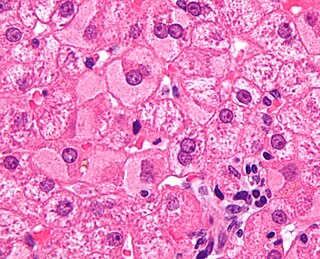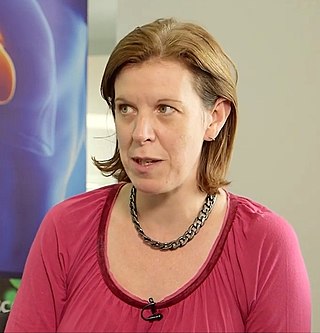
Hepatitis is inflammation of the liver tissue. Some people or animals with hepatitis have no symptoms, whereas others develop yellow discoloration of the skin and whites of the eyes (jaundice), poor appetite, vomiting, tiredness, abdominal pain, and diarrhea. Hepatitis is acute if it resolves within six months, and chronic if it lasts longer than six months. Acute hepatitis can resolve on its own, progress to chronic hepatitis, or (rarely) result in acute liver failure. Chronic hepatitis may progress to scarring of the liver (cirrhosis), liver failure, and liver cancer.

Hepatitis C is an infectious disease caused by the hepatitis C virus (HCV) that primarily affects the liver; it is a type of viral hepatitis. During the initial infection period, people often have mild or no symptoms. Early symptoms can include fever, dark urine, abdominal pain, and yellow tinged skin. The virus persists in the liver, becoming chronic, in about 70% of those initially infected. Early on, chronic infection typically has no symptoms. Over many years however, it often leads to liver disease and occasionally cirrhosis. In some cases, those with cirrhosis will develop serious complications such as liver failure, liver cancer, or dilated blood vessels in the esophagus and stomach.

Adenoviruses are medium-sized, nonenveloped viruses with an icosahedral nucleocapsid containing a double-stranded DNA genome. Their name derives from their initial isolation from human adenoids in 1953.

Viral hepatitis is liver inflammation due to a viral infection. It may present in acute form as a recent infection with relatively rapid onset, or in chronic form, typically progressing from a long-lasting asymptomatic condition up to a decompensated hepatic disease and hepatocellular carcinoma (HCC).

Nipah virus is a bat-borne, zoonotic virus that causes Nipah virus infection in humans and other animals, a disease with a very high mortality rate (40-75%). Numerous disease outbreaks caused by Nipah virus have occurred in South East Africa and Southeast Asia. Nipah virus belongs to the genus Henipavirus along with the Hendra virus, which has also caused disease outbreaks.

Hepatitis A vaccine is a vaccine that prevents hepatitis A. It is effective in around 95% of cases and lasts for at least twenty years and possibly a person's entire life. If given, two doses are recommended beginning after the age of one. It is given by injection into a muscle. The first hepatitis A vaccine was approved in Europe in 1991, and the United States in 1995. It is on the World Health Organization's List of Essential Medicines.

A virus is a tiny infectious agent that reproduces inside the cells of living hosts. When infected, the host cell is forced to rapidly produce thousands of identical copies of the original virus. Unlike most living things, viruses do not have cells that divide; new viruses assemble in the infected host cell. But unlike simpler infectious agents like prions, they contain genes, which allow them to mutate and evolve. Over 4,800 species of viruses have been described in detail out of the millions in the environment. Their origin is unclear: some may have evolved from plasmids—pieces of DNA that can move between cells—while others may have evolved from bacteria.
A hepatitis C vaccine, a vaccine capable of protecting against the hepatitis C virus (HCV), is not yet available. Although vaccines exist for hepatitis A and hepatitis B, development of an HCV vaccine has presented challenges. No vaccine is currently available, but several vaccines are currently under development.
Sir Adrian Vivian Sinton Hill, is an Irish vaccinologist, Director of the Jenner Institute and Lakshmi Mittal and Family Professor of Vaccinology at the University of Oxford, an honorary Consultant Physician in Infectious Diseases, and Fellow of Magdalen College, Oxford. Hill is a leader in the field of malaria vaccine development and was a co-leader of the research team which produced the Oxford–AstraZeneca COVID-19 vaccine, along with Professor Sarah Gilbert of the Jenner Institute and Professor Andrew Pollard of the Oxford Vaccine Group.

Sir Andrew James McMichael, is an immunologist, Professor of Molecular Medicine, and previously Director of the Weatherall Institute of Molecular Medicine at the University of Oxford. He is particularly known for his work on T cell responses to viral infections such as influenza and HIV.

Helen Irene McShane is a British infectious disease physician and a professor of vaccinology, in the Jenner Institute at the University of Oxford, where she has led the tuberculosis vaccine research group since 2001. She is senior research fellow at Harris Manchester College, Oxford.

Dame Sarah Catherine Gilbert FRS is an English vaccinologist who is a Professor of Vaccinology at the University of Oxford and co-founder of Vaccitech. She specialises in the development of vaccines against influenza and emerging viral pathogens. She led the development and testing of the universal flu vaccine, which underwent clinical trials in 2011.

Barinthus Biotherapeutics plc is a biotechnology company developing immunotherapies for infectious diseases, cancer and autoimmune diseases such as hepatitis B, HPV and prostate cancer. Formerly known as Vaccitech plc, in November 2023 the company announced that it had renamed itself to Barinthus Biotherapeutics plc.
Catherine Mary Green is an English biologist who is an Associate Professor in Chromosome Dynamics at the Wellcome Centre for Human Genetics at the University of Oxford. Her research considers chromosome stability during the replication of DNA. During the COVID-19 pandemic Green was part of the Oxford team who developed the Oxford–AstraZeneca COVID-19 vaccine.
Tao Dong is a Chinese-British immunologist who is Professor of Immunology at Oxford University. Her work focuses on the study of T-cells which respond to viral infections and viral associated cancer. She is a founding director for both the CAMS-Oxford joint International Center for Transnational Immunology and the Chinese Academy of Medical Sciences Oxford Institute (COI).
Katie Jane Ewer is a British immunologist and Professor of Vaccine Immunology at the University of Oxford's Jenner Institute.
ChAdOx1 is an adenoviral vector for vaccines that was developed by the Jenner Institute, University of Oxford. The vector is a chimpanzee adenovirus modified to avoid its replication.

A viral vector vaccine is a vaccine that uses a viral vector to deliver genetic material (DNA) that can be transcribed by the recipient's host cells as mRNA coding for a desired protein, or antigen, to elicit an immune response. As of April 2021, six viral vector vaccines, four COVID-19 vaccines and two Ebola vaccines, have been authorized for use in humans.
Eleanor Barnes is a British physician at the John Radcliffe Hospital and a Professor of Hepatology and Experimental Medicine at the University of Oxford. She has studied hepatitis C and the development of the development of HCV vaccines. She is a Fellow of the Academy of Medical Sciences and serves as the lead for hepatology at the National Institute for Health Research (NIHR) Clinical Research Network.

Susanna Jane Dunachie is a British microbiologist who is Professor of Infectious Diseases at the University of Oxford. Her work considers microbiology and immunology to better understand bacterial infection and accelerate the development of vaccines. She has focused on melioidosis, scrub typhus and tuberculosis. During the COVID-19 pandemic, she studied T cell immunity to severe acute respiratory syndrome coronavirus 2.












